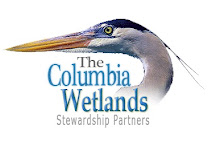 |
| Photo by Larry Halverson |
Great Horned is one of the most common owls in the Columbia Wetlands. It also the earliest nesting owl so now is time to hear them calling.
Most species of owls are secretive and nocturnal, making population monitoring a difficult science. Fortunately, volunteer owl surveyors across Canada are listening for owl calls in the night and documenting their numbers over time. The Nocturnal owl survey in British Columbia is now in its 11th year. There are 105 owl routes across BC and the Yukon. In 2010, 86 owlers stopped 1205 times in the darkness to listen for owls. They detected 248 owls, an average of 2.06 owls per 10 stops, which is the second highest value reported in the history of the survey. In the southern interior of BC the Northern Saw-whet Owl was the most common owl heard followed by the Great Horned Owl and Barred Owl.






